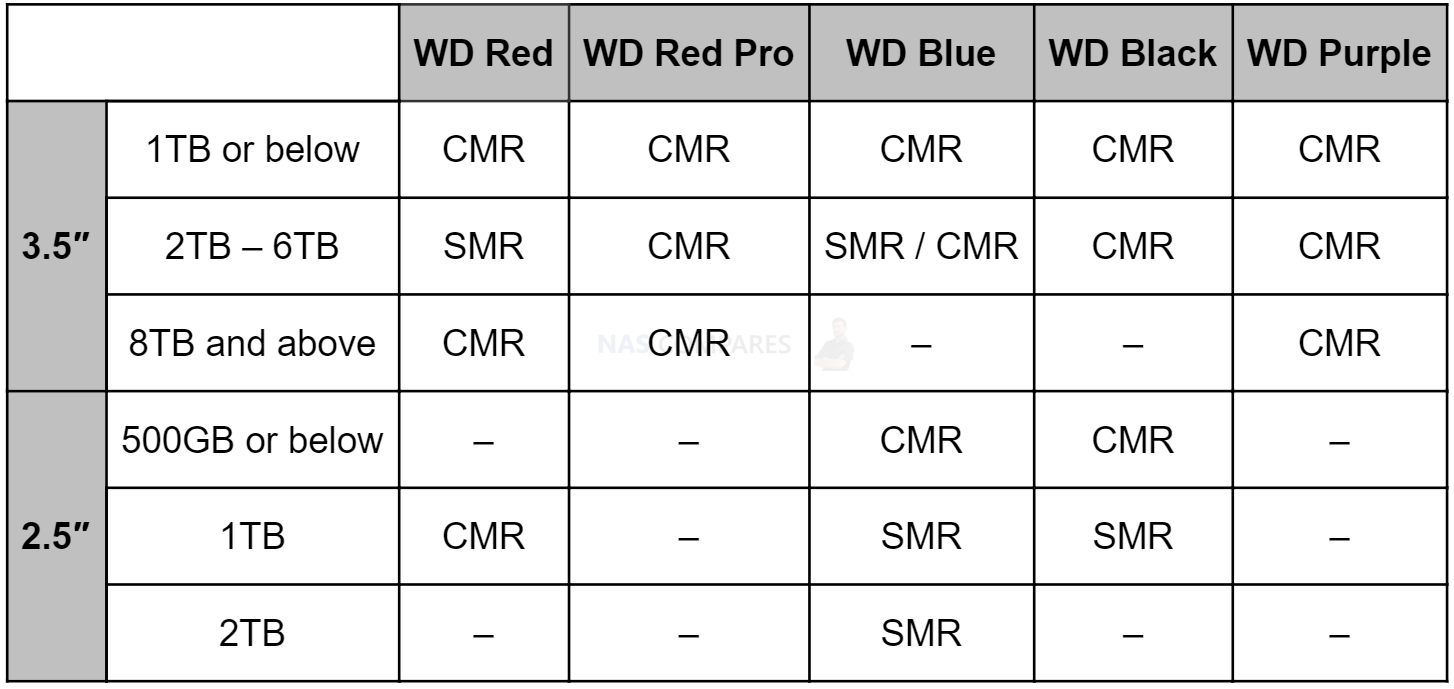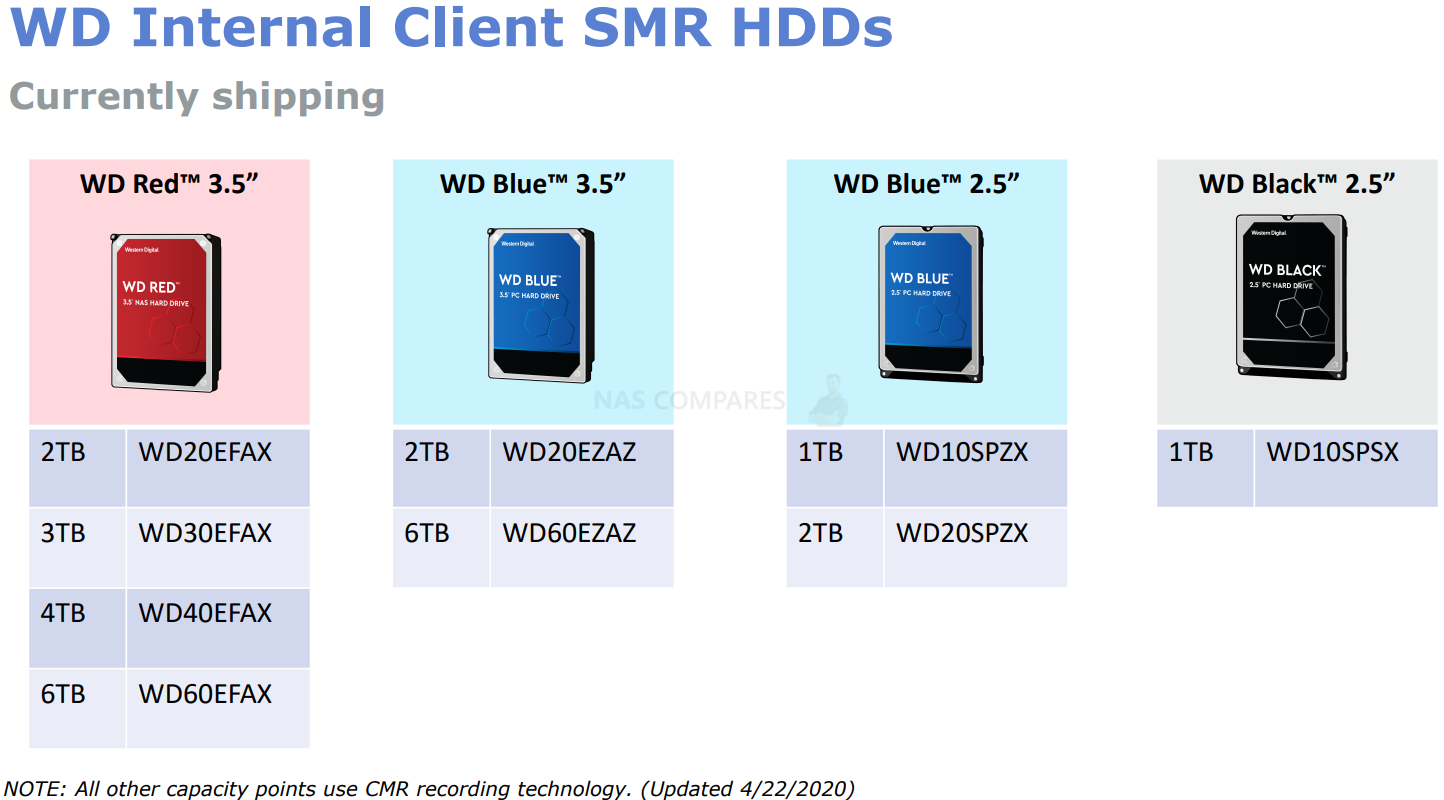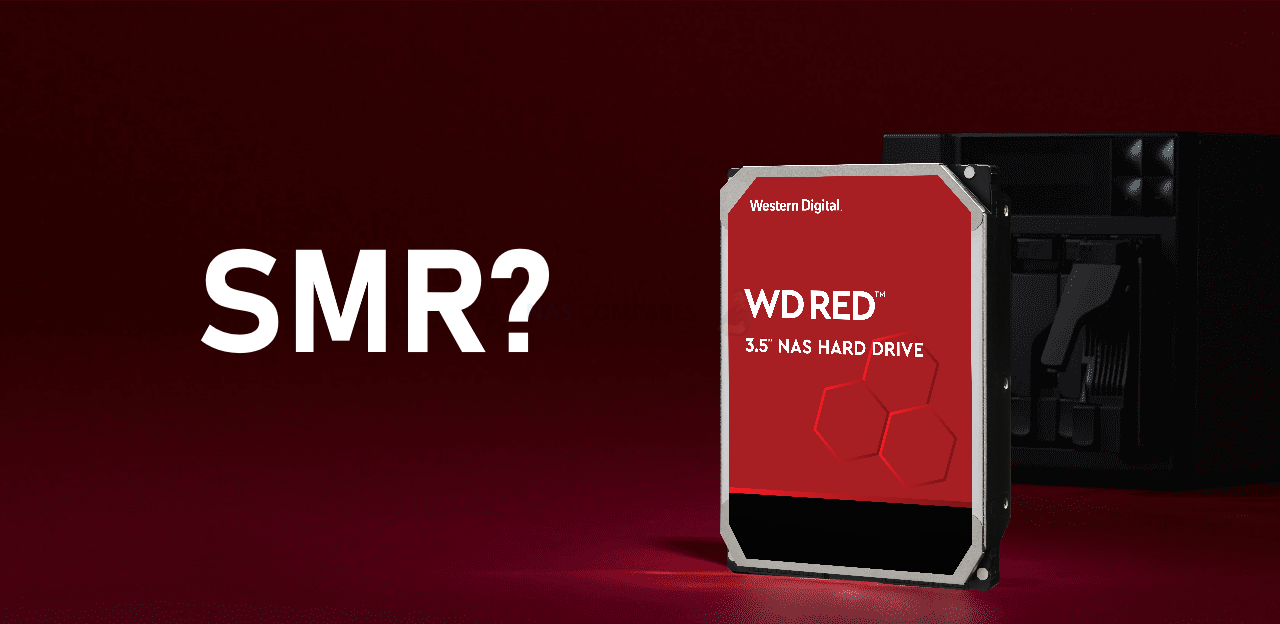WD Red 2TB, 4TB and 6TB NAS Hard Drives Use SMR / DM-SMR
IMPORTANT – This Article has been updated on 23/04/2020 with Information Provided by an official statement and hardware breakdown from Western Digital, from their official blog. This post has been updated accordingly with these new details.
WD Statement:
“The past week has been eventful, to say the least. As a team, it was important that we listened carefully and understood your feedback about our WD Red NAS drives, specifically how we communicated which recording technologies are used. Your concerns were heard loud and clear. Here is that list of our client internal HDDs available through the channel:”

See Below for SKUs to our client internal HDDs using SMR technology.

“We’re committed to providing the information that can help make an informed buying decision for as many uses as possible. Thank you for letting us know how we can do better. We will update our marketing materials, as well as provide more information about SMR technology, including benchmarks and ideal use cases. Again, we know you entrust your data to our products, and we don’t take that lightly. If you have purchased a drive, please call our customer care if you are experiencing performance or any other technical issues. We will have options for you. We are here to help.”
20-04-2020 – Official Statement from Western Digital on this matter
“Recently, there has been a discussion regarding the recording technology used in some of our WD Red hard disk drives (HDDs). We regret any misunderstanding and want to take a few minutes to discuss the drives and provide some additional information. WD Red HDDs are ideal for home and small businesses using NAS systems. They are great for sharing and backing up files using one to eight drive bays and for a workload rate of 180 TB a year. We’ve rigorously tested this type of use and have been validated by the major NAS providers. We typically specify the designed-for use cases and performance parameters and don’t always talk about what’s under the hood. One of those innovations is Shingled Magnetic Recording (SMR) technology.
SMR is tested and proven technology that enables us to keep up with the growing volume of data for personal and business use. We are continuously innovating to advance it. SMR technology is implemented in different ways – drive-managed SMR (DMSMR), on the device itself, as in the case of our lower capacity (2TB – 6TB) WD Red HDDs, and host-managed SMR, which is used in high-capacity data center applications. Each implementation serves a different use case, ranging from personal computing to some of the largest data centers in the world.
DMSMR is designed to manage intelligent data placement within the drive, rather than relying on the host, thus enabling a seamless integration for end users. The data intensity of typical small business/home NAS workloads is intermittent, leaving sufficient idle time for DMSMR drives to perform background data management tasks as needed and continue an optimal performance experience for users. WD Red HDDs have for many years reliably powered home and small business NAS systems around the world and have been consistently validated by major NAS manufacturers. Having built this reputation, we understand that, at times, our drives may be used in system workloads far exceeding their intended uses. Additionally, some of you have recently shared that in certain, more data intensive, continuous read/write use cases, the WD Red HDD-powered NAS systems are not performing as you would expect.”
The Original NASCompares News-Post on these WD Red Drives:
Over the last few days, a story has been circulating that revolves around WD Red NAS Hard Drives and their potential use of shingled magnetic recording (SMR) and a statement has been shared by the brand highlighting that this is indeed the case, namely, drive managed shingled magnetic recording (DM-SMR). Now, it turns out this is something that many platforms and solo users online had reached the conclusion of as early as July 2019 and when reaching out to WD, and was met with less than immediate responses. But now it appears that the WD Red 2TB, 4TB and 6TB Standard class NAS 3.5″ Hard Drives do indeed feature this method of platter utilization inside and it’s upset a few people indeed, but the details are not as black and white as some might think. So, what is SMR, Should you be concerned, What does this mean for bigger WD Red Capacities and How is WD responding to this? Let’s take a look at the news.
What has WD Told us so far?
We reached out to WD and we were furnished with the following reply by Yemi Elegunde, Enterprise & Channel Sales Manager Western Digital UK:
Shingled magnetic recording (SMR) is a hard drive technology that efficiently increases areal density and capacity for users managing increasing amounts of data, thus lowering users’ TCO. There are both device-managed and host-managed types, each for different use cases. All our WD Red drives are designed to meet or exceed the performance requirements and specifications for common and intended small business/home NAS workloads. WD Red capacities 2TB-6TB currently employ device-managed shingled magnetic recording (DMSMR) to maximize areal density and capacity. WD Red 8-14TB drives use conventional magnetic recording (CMR). DMSMR should not be confused with host-managed SMR (HMSMR), which is designed for data center applications having respective workload requirements and host integration.
Shingled magnetic recording (SMR) is a hard drive technology that efficiently increases areal density and capacity for users managing increasing amounts of data, thus lowering users’ TCO. There are both device-managed and host-managed types, each for different use cases. All our WD Red drives are designed to meet or exceed the performance requirements and specifications for common and intended small business/home NAS workloads. WD Red capacities 2TB-6TB currently employ device-managed shingled magnetic recording (DMSMR) to maximize areal density and capacity. WD Red 8-14TB drives use conventional magnetic recording (CMR). DMSMR should not be confused with host-managed SMR (HMSMR), which is designed for data center applications having respective workload requirements and host integration.
DMSMR is designed to manage intelligent data placement within the drive, rather than relying on the host, thus enabling a seamless integration for end users. The data intensity of typical small business/home NAS workloads is intermittent, leaving sufficient idle time for DMSMR drives to perform background data management tasks as needed and continue an optimal performance experience for users.
WD Red drives are designed and tested for an annualized workload rate up to 180TB. Western Digital has seen reports of WD Red use in workloads far exceeding our specs and recommendations. Should users’ use cases exceed intended workloads, we recommend WD Red Pro or Ultrastar data center drives. Western Digital works extensively with customers and the NAS vendor and partner communities to continually optimize our technology and products for common uses cases. In collaboration with major NAS providers, we work to ensure WD Red HDDs (and SSDs) at all capacities are compatible with a broad set of host systems. In our testing of WD Red drives, we have not found RAID rebuild issues due to DMSMR technology.
Our customers’ experience is important to us. We will continue listening to and collaborating with the broad customer and partner communities to innovate technologies that enable better experiences with, more efficient management of and faster decisions from data.”
When asked why has Western Digital excluded a recording type specification in the datasheet specifications, Yemi stated:
Most of our customers choose our drives based on specific performance attributes of their use cases, such as transfer and workload rates, and it is our goal to make that information very clear on all of our materials.
What are DM-SMR, HS-SMR and HA-SMR?
Essentially, SMR comes in three variations – DMSMR, HMSMR and HASMR. There are key differences between them and this should be considered by the host software requirements and drive performance characteristics that are needed at the end-user level.
What is Drive-Managed SMR (DM-SMR)
Drive-managed SMR, where the drive manages all write commands from the host, allows a plug-and-play implementation, compatible with any hardware and software. However, the background ‘housekeeping’ tasks that the drive must perform result in highly unpredictable performance, unfit for enterprise workloads.
What is Host-Managed SMR (HM-SMR)
In contrast to drive-managed SMR, host-managed SMR is an implementation where the host is responsible for everything ranging from managing data streams, to read/write operations and zone management. Host-managed SMR requires host-software modification so that the host system has knowledge of the underlying media and can micro-control all elements by employing a new set of commands. Depending on the system architecture, implementing these modifications may seem like an onerous task, yet once developers gain SMR familiarity and optimize their applications for sequential writing, they can take advantage of unsurpassed levels of reliability and quality. With the ability to deliver predictable, consistent performance comparable to what users expect from traditional PMR drives, host-managed SMR is emerging as the preferred option for implementing shingled magnetic recording.
What is Host-Aware SMR (HA-SMR)
Host-aware SMR is like a superset of the aforementioned options. On the surface, this may seem like the best of both worlds. However, if predictability and reliability are what you are after, you cannot take any shortcuts in modifying your stack as you would for host-managed SMR. As such, host-managed SMR allows for a smooth, staged transition to Host-aware SMR in a future timeframe.
What is SMR and Why Should NAS Drives Avoid it in their HDDs?
As mentioned, Shingled media recording (SMR) HDDs take advantage of disk write tracks being wider than read tracks to partially overlapping write tracks and so enable more tracks to be written to a disk platter. This means more data can be stored on a shingled disk than an ordinary drive. This serves as hugely useful for archive and cold storage use and has been popularized in that area for a while. However, typically SMR drives are not intended for random write IO use cases because the write performance is much slower than with a non SMR drive. Therefore they are not recommended for NAS use cases in most industries, as they feature significant random write workloads. For a while now, data storage enthusiasts have been wondering why some of their WD Red NAS drives have been failing with their RAID/ZFS arrays and/or exhibiting signs of slower performance. It turns out that many of these HDDs actually use shingled magnetic recording (SMR) instead of perpendicular (conventional) magnetic recording (PMR/CMR) technology. A full statement is below (from guru3D):
“All our WD Red drives are designed meet or exceed the performance requirements and specifications for common small business/home NAS workloads. We work closely with major NAS providers to ensure WD Red HDDs (and SSDs) at all capacities have broad compatibility with host systems. Currently, Western Digital’s WD Red 2TB-6TB drives are device-managed SMR (DMSMR). WD Red 8TB-14TB drives are CMR-based. You are correct that we do not specify recording technology in our WD Red HDD documentation.
We strive to make the experience for our NAS customers seamless, and recording technology typically does not impact small business/home NAS-based use cases. In device-managed SMR HDDs, the drive does its internal data management during idle times. In a typical small business/home NAS environment, workloads tend to be bursty in nature, leaving sufficient idle time for garbage collection and other maintenance operations. In our testing of WD Red drives, we have not found RAID rebuild issues due to SMR technology. We would be happy to work with customers on experiences they may have, but would need further, detailed information for each individual situation.”
Why Would WD Red Use SMR on their NAS Hard Drives?
While SMR allows for greater areal density (i.e., higher drive capacity), it’s inherently inferior to PMR/CMR based on the way it writes data. The fact that WD is stating that these capacities of WD Red (2,4,6TB) use Drive Managed SMR is better than we first thought, it is still off that it is not a factor presented in their datasheets and technical literature. As Synology explains, “rather than writing each magnetic track without overlapping, SMR overlaps each new track with part of the previously written track, much like shingles on a roof.” The result is slower performance and, as evidenced by recurring complaints on r/DataHoarders, problems with RAID arrays. Tom’s Hardware compares this blip in info sharing to an SSD manufacturer selling a drive with cheaper NAND (e.g. QLC) and not disclosing it. It isn’t clear whether Western Digital will update its marketing materials to show that its 2 TB – 6 TB Red NAS are SMR drives. Back in 2016 we performed speed test on Seagate SMR Archive drives and found them to be good as a standalone drive, but unsurprisingly lacked the robust group utility of RAID use overall:
Additionally, Right the way back in 2015 (almost right at the start of the SPANtv YouTube Channel history in fact) we discussed the difference between the larger HDDs that were coming to market that used either SMR or Helium Based storage capacity. If you can endure the terrible green screen use and my UTTER inability to pronounce the H correctly, it may well serve as an early window into how this kind of tech was being distinguished even 5 years ago.
What Should I Do About my WD Red NAS Hard Drives?
We will update you more and more on how this will pan out, as well as how WD is going to respond to those that have long term concerns about their data moving forward. Unless you are using your NAS Drive is an enterprise or heavy-duty capacity, this is not something that is mission-critical in the short term and as long as you have a multi-tiered backup and run checked periodically internally on your RAID array and using the NAS storage tools provided – though you should consider the importance of this in conjunction with the importance of your data! A firmware upgrade is not possible, as this is a physical build matter and likewise, simply swapping all the drives over is not an option (if indeed necessary) as these drives are likely being used in RAID groups that require gradual and time occupying individual drive replacement and rebuilding/resilvering. Do use the comments section below or the free advice section here at NASCompares to share your thoughts on this or to get some free advice on what you need for your next storage solution moving forward, to avoid any potential hurdles like SMR on your media.
📧 SUBSCRIBE TO OUR NEWSLETTER 🔔🔒 Join Inner Circle
Get an alert every time something gets added to this specific article!
This description contains links to Amazon. These links will take you to some of the products mentioned in today's content. As an Amazon Associate, I earn from qualifying purchases. Visit the NASCompares Deal Finder to find the best place to buy this device in your region, based on Service, Support and Reputation - Just Search for your NAS Drive in the Box Below
Need Advice on Data Storage from an Expert?
Finally, for free advice about your setup, just leave a message in the comments below here at NASCompares.com and we will get back to you. Need Help?
Where possible (and where appropriate) please provide as much information about your requirements, as then I can arrange the best answer and solution to your needs. Do not worry about your e-mail address being required, it will NOT be used in a mailing list and will NOT be used in any way other than to respond to your enquiry.
Need Help?
Where possible (and where appropriate) please provide as much information about your requirements, as then I can arrange the best answer and solution to your needs. Do not worry about your e-mail address being required, it will NOT be used in a mailing list and will NOT be used in any way other than to respond to your enquiry.

|
 |
The BEST NAS of 2026.... ALREADY??? (UnifyDrive UP6)
How Much RAM Do You Need in Your NAS?
A Buyer's Guide to Travel Routers - GET IT RIGHT, FIRST TIME
Jonsbo N6 DIY NAS Case Review
The Best Bits (and Worst Bits) of NAS of 2025!
Minisforum MS-02 Ultra Review
Access content via Patreon or KO-FI
Discover more from NAS Compares
Subscribe to get the latest posts sent to your email.






Old video but I m going to give it a shot. So enterprise sata and sas drives like HGST HUH721212AL5200 that WD states them as PMR are DM-SMR? I don t think so even if in the datasheet only state PMR.
PS I know the presentation here is for WD Reds but found it relevant.
REPLY ON YOUTUBE
The dead giveaway that a drive is SMR, is TRIM SUPPORT! … I don’t know WHY manufacturers can’t just be open and transparent about what customers are buying?
REPLY ON YOUTUBE
Using something like a NAS in a home environment, I don’t have constant read/write cycles but I want security and longevity.
I think the conventional recording seems more trustworthy.
REPLY ON YOUTUBE
Drive managed SMR if it did it right, would be invisible. But if its noticable/measurable its not doing it well enough.
REPLY ON YOUTUBE
Glad I got the 16TB WD Gold for my desktop/server host which is on 24/7 but “shouldn’t be” instead. 😛
REPLY ON YOUTUBE
intel is more fraud
REPLY ON YOUTUBE
Funny to see so many uneducated misleading info here about SMR. Just like those people boycott 5G technology.
REPLY ON YOUTUBE